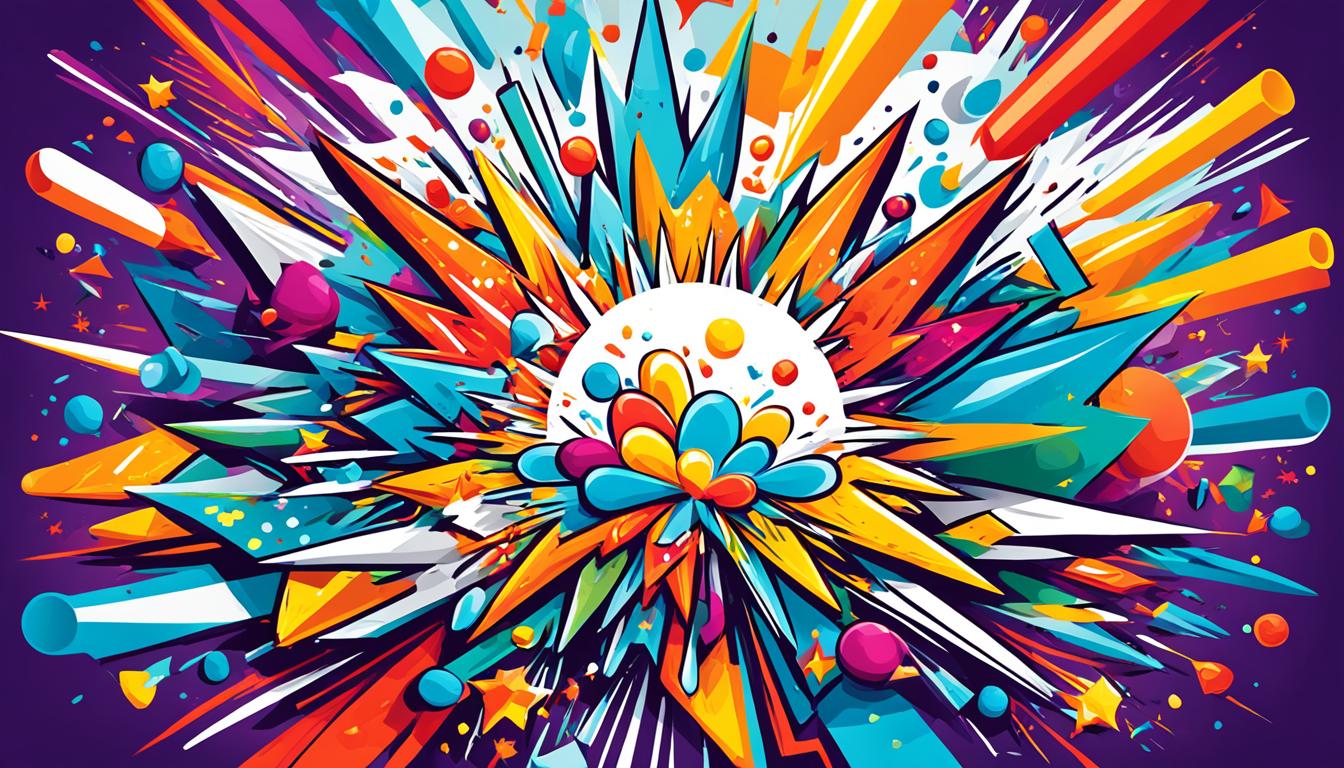Welcome to a world where creativity knows no bounds. Whether you’re an artist, a writer, a musician, or simply someone who wants to infuse more innovation into your everyday life, setting creative goals can be a game-changer. By defining your aspirations and pursuing them with intention, you can unlock the full potential of your creative vision.
Setting goals is not just about achieving outcomes; it’s a pathway to self-discovery and personal development. Creative goals provide a clear direction and focus, preventing creative stagnation and pushing you to explore new horizons. They enable you to overcome challenges, conquer the fear of failure, and embrace the joy of creative accomplishment.
This article will explore 15 creative goals to spark your creativity and propel you toward growth and fulfillment. We’ll cover various strategies to ignite your creative fire, from brainstorming and journaling to learning new artistic skills and finding inspiration.
Key Takeaways:
- Setting creative goals can lead to personal and professional growth.
- Creative goals provide direction and focus, preventing creative stagnation.
- By embracing creative goals, you can overcome challenges and conquer the fear of failure.
- Fifteen creative goals will be explored to propel your creativity toward growth and fulfillment.
- These goals include brainstorming, journaling, learning new artistic skills, and finding inspiration.
Understanding Creativity and its Importance
Creativity is a fundamental aspect of personal and professional success. It enables you to think outside the box and find innovative solutions to challenges, ultimately helping you reach your goals and fulfill your dreams. The ability to approach problems from artistic and unconventional angles empowers you to overcome obstacles and push the boundaries of what is possible.
Without creativity, individuals may face creative stagnation, experiencing a lack of inspiration and difficulty finding solutions to everyday dilemmas. Cultivating and nurturing your creative skills is essential for a fulfilling and successful life, as it allows you to explore new possibilities, embrace novel perspectives, and embrace change.
“Creativity is thinking up new things. Innovation is doing new things.” – Theodore Levitt.
Importance of Creativity in Success
Embracing creativity opens doors to success. It encourages you to tap into your artistic abilities and use your unique skills to stand out. By thinking outside the box, you can develop innovative ideas and approaches that differentiate you from others in your field, leading to professional recognition and advancement.
Creative individuals are not afraid to take risks and explore uncharted territories. They challenge the status quo, constantly seeking improvement and growth. They can adapt to changing circumstances, allowing them to overcome challenges and seize opportunities that may elude others. Through creativity, you can truly unlock your potential and discover new horizons.
“The only way to do great work is to love what you do.” – Steve Jobs
Cultivating Artistic Skills and Reaching Goals
Artistic skills play a vital role in creativity. They enable you to communicate your ideas effectively through visual arts, writing, music, or other forms of expression. By honing your artistic abilities, you enhance your creative repertoire and expand your capacity for innovation.
When you align your creativity with specific goals, you give your imagination a clear direction and purpose. Setting creative goals helps you maintain focus and motivation, facilitating progress and accomplishment in various aspects of your life. You can turn your dreams into reality by combining your artistic skills with a goal-oriented mindset.
| Skills | Outcomes | |
|---|---|---|
| Thinking outside the box | Discovering innovative solutions | |
| Embracing challenges | Overcoming obstacles and setbacks | |
| Adapting to change | Seizing new opportunities | |
| Tapping into artistic skills | Expressing ideas effectively | |
| Focusing on goals | Achieving desired outcomes |
Remember, creativity is a force that propels you forward, allowing you to surpass your limitations and explore uncharted territories. By embracing your imaginative abilities and cultivating your artistic skills, you can unlock a world of possibilities and chart a path toward personal and professional success.

Continue reading to discover creativity goals and how they can help unleash your full creative potential.
What are Creativity Goals?
In your creative journey, clear objectives are essential for growth and development. Creativity goals are specific targets that you set to improve your creative skills and expand your creative repertoire. By setting creative goals, you can enhance your work results, prevent creative stagnation, and gain a sense of direction and focus in your creative pursuits.
Achieving creativity goals brings forth numerous benefits, both personally and professionally. It allows you to tap into your creative potential and push the boundaries of your imagination. By actively working towards your goals, you can sharpen your creative skills, broaden your creative repertoire, and bring new levels of innovation to your work.
Not only do creativity goals help you develop specific creative skills, but they also encourage an ongoing cycle of growth and improvement. You build momentum as you accomplish each goal and inspire yourself to set even more ambitious objectives. This cycle of setting and achieving creativity goals pave the way for continuous personal growth and increased satisfaction in your creative endeavors.
Furthermore, creativity goals provide structure and purpose in your creative journey. With clearly defined objectives, you can channel your efforts toward meaningful growth and development. By having a focused direction, you can avoid creative stagnation and ensure your work remains fresh, innovative, and exciting.
Overall, setting and achieving creativity goals offer a multitude of benefits, including:
- Personal growth and self-discovery
- Enhanced creative skills and techniques
- Expanded creative repertoire
- Improved work results and outcomes
- Prevention of creative stagnation
- Increased direction and focus in creative pursuits
- Heightened satisfaction and fulfillment
- Greater overall well-being
Setting creative goals is an empowering and transformative process that allows you to unlock your full creative potential. By diligently working towards these objectives, you can experience remarkable growth and achieve a level of creativity that surpasses your wildest dreams.
Examples of Creativity Goals
Setting creative goals is a fantastic way to enhance your creative skills, expand your abilities, and promote personal and professional growth. Here are some examples of creativity goals that you can incorporate into your journey:
- Brainstorming: Practice brainstorming sessions to generate innovative ideas and solutions.
- Journaling: Keep a journal to record your thoughts, ideas, and inspirations.
- Open-mindedness: Cultivate an open mind to embrace new perspectives and ideas.
- Learning artistic skills: Explore and learn new creative skills such as painting, photography, or playing a musical instrument.
- Daydreaming: Allow yourself to daydream and let your imagination roam freely.
- Staying optimistic: Maintain a positive mindset to overcome challenges and setbacks.
- Improv: Engage in improvisational activities to enhance your spontaneity and creative thinking.
- Fear of failure: Overcome the fear of failure by taking calculated risks and embracing mistakes as learning opportunities.
- Mind maps: Utilize mind maps as a visual tool to explore ideas, connections, and possibilities.
- Finding inspiration: Actively seek out sources of inspiration, such as nature, art, or conversations with others.
- Reading books: Immerse yourself in books across different genres to expand your knowledge and spark new ideas.
Incorporating these creativity goals into your daily life allows you to foster a creative mindset, think innovatively, and unlock your full creative potential.

Achieving Creativity Goals Through the SMART Framework
The SMART framework is a goal-setting approach that can help you achieve your creativity goals. SMART stands for Specific, Measurable, Attainable, Relevant, and Time-Based. This framework can make your creativity goals more manageable, enjoyable, and attainable.
“Setting specific and realistic objectives, breaking down goals into smaller ones, and taking step-by-step actions towards achieving them.”
Specific
When setting creativity goals, it’s essential to be specific. Instead of saying, “I want to be more creative,” consider setting an objective like “I want to learn to paint with watercolors.”
Measurable
Ensure that your creativity goals are measurable. This means setting goals that you can track your progress towards. For example, you could set a goal to complete one watercolor painting per week.
Attainable
Make sure your creativity goals are attainable. It’s essential to set goals that are challenging but still within reach. Setting goals that are too tricky can be discouraging, so be realistic about what you can achieve.
Relevant
Your creativity goals should be relevant to your overall creative vision and aspirations. Consider how each goal contributes to your personal development and artistic growth.
Time-Based
Set a timeframe for achieving your creativity goals. This will help create a sense of urgency and provide accountability. For example, you could aim to complete a series of watercolor paintings within three months.
Applying the SMART framework allows you to break your creativity goals into smaller, actionable steps. This makes the process less overwhelming and more enjoyable. Remember to celebrate your progress and have fun along the way!

| SMART Framework Steps | Explanation |
|---|---|
| Specific | Set clear and specific creativity goals. |
| Measurable | Create goals that are measurable and trackable. |
| Attainable | Set goals that are challenging but within reach. |
| Relevant | Ensure your goals are relevant to your creative vision. |
| Time-Based | Set a timeline for achieving your creativity goals. |
The Relationship Between Creativity and Goal Setting
Creativity and goal setting are not mutually exclusive. While creativity is often seen as spontaneous and unplanned, goal setting can provide structure and planning for creative pursuits. Creativity goals serve as living proof that creativity and goal setting go hand in hand.
Creative individuals understand the importance of having a clear plan and utilizing goal-setting strategies to succeed. By setting and accomplishing creative goals, individuals can tap into their creative potential, take risks, and explore new ideas and possibilities.
“Creativity is intelligence having fun.” – Albert Einstein
Having goals in place allows creative individuals to channel their creativity in a focused manner, giving them a sense of direction and purpose. It provides a framework to innovate and turn their ideas into tangible outcomes.
Individuals can define their creative goals by defining the steps and actions needed to bring their visions to life. This structured approach helps them overcome challenges, stay motivated, and achieve innovative results.
Creativity Goals and Risk-Taking
Setting creativity goals also encourages individuals to take risks. Creative individuals often must step outside their comfort zones to break free from conventional thinking and explore new possibilities.
Goal setting provides the motivation and courage necessary to take calculated risks. It pushes individuals to embrace new ideas, experiment with different approaches, and challenge the status quo. These risks often lead to breakthrough moments and innovative solutions.
Structure and Spontaneity: Striking the Balance
While goal setting provides structure and planning, it is essential to strike a balance with spontaneity. Creativity thrives when individuals allow themselves to deviate from the plan, explore unexpected avenues, and embrace moments of inspiration.
Creative individuals can find the ideal balance between structure and freedom by combining goal setting with a willingness to flow spontaneously. This allows them to harness their creativity most effectively and authentically.

Individuals can unlock their full creative potential by recognizing the relationship between creativity and goal setting. From innovative artists to successful entrepreneurs, countless individuals have achieved remarkable success by setting and pursuing creative goals.
So, embrace the power of goal setting to fuel your creativity, take calculated risks, and turn your dreams into reality. With a clear plan, you can navigate the creative process confidently, innovate, and have a greater chance of achieving your creative goals.
| Benefits of Creativity Goals | Benefits of Goal Setting |
|---|---|
| 1. Personal and professional growth | 1. Greater focus and direction |
| 2. Enhanced problem-solving skills | 2. Increased motivation and accountability |
| 3. Expanded creative abilities | 3. Improved time management |
| 4. Breakthrough moments and innovative solutions | 4. Achievement of desired outcomes |
| 5. Personal fulfillment and satisfaction | 5. Development of new skills and knowledge |
How to Enhance and Nurture Creativity
Enhancing and nurturing creativity is essential for unlocking your creative genius and fostering innovation in various areas of life. Here are some strategies that can help you improve your creativity:
- Practice Silence or Meditation: Taking moments of silence or practicing meditation can help clear your mind, reduce distractions, and enhance your focus, allowing your creativity to flourish.
- Engage in Social Interaction: Social interaction with like-minded individuals can stimulate new ideas, offer different perspectives, and provide valuable feedback, building a positive environment for creativity.
- Cultivate a Positive Mindset: Embracing positivity and maintaining an optimistic outlook can fuel your creative thinking and allow you to approach challenges with resilience and a growth mindset.
- Daydream and Doodle: Giving yourself time to daydream and doodle can activate your imagination, spark new ideas, and provide a creative outlet for self-expression.
- Expand Your Knowledge and Experiences: Continually seek new experiences, explore different fields, and expand your knowledge base to gain fresh insights and cross-pollinate ideas.
- Seek Inspiration: Surround yourself with inspiring people, environments, and resources that ignite your imagination and push you to think outside the box.
- Stay Focused: Cultivate the ability to concentrate intensely on your creative pursuits by minimizing distractions, setting specific goals, and dedicating uninterrupted time to your creative endeavors.
- Think Outside the Box: Challenge conventional thinking and embrace unconventional approaches to problem-solving, allowing yourself to explore new possibilities and unleash your creative potential.
- Maintain a Positive Attitude: Embrace a positive attitude towards failures, setbacks, and challenges, viewing them as opportunities for growth and learning rather than roadblocks.
- Practice Regularly: Regular practice is crucial in honing your creative skills and staying in touch with your creative flow. Set aside dedicated time for creative activities and make them a habit.
- Allow for Rest and Rejuvenation: Rest is crucial for recharging your creative energy. Allow yourself time for relaxation, self-care, and leisure activities to keep your creative fire burning.
- Revise Goals When Needed: Periodically reassess your creative goals, making adjustments and revisions to align with your evolving interests, aspirations, and creative vision.
- Take Notes to Capture Ideas: Keep a journal or use digital tools to capture your ideas, observations, and inspirations. Reviewing your notes can serve as a wellspring of creativity and inspiration.
- Ask Questions to Stimulate Creative Thinking: Foster curiosity and intellectual growth by asking thought-provoking questions, challenging assumptions, and seeking answers beyond what is readily available.
By incorporating these strategies into your creative practice, you can enhance your creativity, unlock your creative genius, and open up new realms of innovation and self-expression.
| Strategies | Benefits |
|---|---|
| Practice silence or meditation | Enhanced focus and clarity of thought |
| Engage in social interaction | Exchange of ideas and diverse perspectives |
| Cultivate a positive mindset | Increased resilience and creative thinking |
| Daydream and doodle | Stimulation of imagination and self-expression |
| Expand knowledge and experiences | Cross-pollination of ideas and fresh insights |
| Seek inspiration | Ignition of creativity through inspiring influences |
| Think outside the box | Exploration of unconventional solutions and ideas |
| Maintain a positive attitude | Embracing growth and overcoming challenges |
The Benefits of Creativity for Personal Growth
Creativity is crucial in personal growth, bringing numerous benefits to various aspects of your life. Engaging in creative activities brings you joy and happiness and enhances your overall well-being and satisfaction. Let’s explore the positive outcomes that creativity can bring to your growth journey.
1. Increased Happiness and Well-being
When you embrace creativity, you tap into a source of positive emotions and experiences, which naturally contribute to increased happiness and well-being. Engaging in creative pursuits brings you joy and a sense of fulfillment, boosting your overall mood and outlook.
2. Fosters Innovation and Out-of-the-Box Thinking
“Creativity is intelligence having fun.” – Albert Einstein
Creativity nurtures innovative thinking, allowing you to break free from traditional patterns and develop fresh and unique ideas. It will enable you to think outside the box, fostering innovation and opening up new possibilities in your life.
3. Promotes Self-Expression and Authenticity
Expressing yourself creatively allows you to showcase your unique ideas, perspectives, and talents. It encourages self-expression and authenticity, empowering you to communicate your thoughts and emotions in a way that is true to yourself.
4. Encourages Hard Work and Dedication
Creative endeavors often require dedication, perseverance, and hard work. By embracing creativity, you develop a strong work ethic and learn the value of committing yourself to a project or pursuit. This hard work and dedication contribute to personal growth and self-improvement.
5. Unleashes Personal Growth and Exploration
Through creativity, you can explore new ideas, discover hidden talents, and challenge yourself. This process of exploration and growth expands your horizons, helping you develop new skills, broaden your perspectives, and unlock your full potential.
| Benefits of Creativity for Personal Growth | |
|---|---|
| Increased happiness and well-being | 🌟 |
| Fosters innovation and out-of-the-box thinking | 🌟 |
| Promotes self-expression and authenticity | 🌟 |
| Encourages hard work and dedication | 🌟 |
| Unleashes personal growth and exploration | 🌟 |
By embracing and incorporating creativity into your life, you embark on a journey of personal growth and self-discovery. The benefits of creativity extend far beyond the artistic realm, influencing your mindset, emotions, and overall outlook on life. It’s time to unlock your creative potential and experience the transformative power of creativity.
Conclusion
Setting and achieving creative goals is crucial for your personal and professional growth. Following the SMART framework and nurturing your creativity through various strategies can enhance your creative skills, expand your creative repertoire, and experience numerous benefits. Embracing creativity and setting goals can lead to a more fulfilling and successful life.
When you set creative goals using the SMART framework – Specific, Measurable, Attainable, Relevant, and Time-Based – you give yourself a clear direction and a roadmap for success. Breaking down your creative goals into smaller, manageable steps allows you to make progress and avoid feeling overwhelmed.
Nurturing your creativity through practices such as silence or meditation, social interaction, a positive mindset, and seeking inspiration helps you unlock your creative genius and think outside the box. Embracing creativity enhances your personal growth and boosts your well-being, satisfaction, and overall happiness.
So start your creative journey today. Set those creative goals, follow the SMART framework, and nurture your creativity. Unleash your full creative potential and experience personal and professional growth benefits, increased well-being, and overall life satisfaction.
FAQ
What are creative goals?
Creative goals are objectives that individuals set to improve their creative skills and expand their creativity. They can involve activities such as brainstorming, keeping a journal, being open-minded, learning new artistic skills, daydreaming, and finding inspiration.
Why are creativity goals important?
Setting creativity goals can lead to personal and professional growth, prevent creative stagnation, provide a sense of direction and focus, and ultimately enhance one’s overall well-being and satisfaction in life.
What are some examples of creativity goals?
Examples of creativity goals include practicing brainstorming, keeping a journal, learning a new artistic skill, staying optimistic, overcoming the fear of failure, using mind maps, finding inspiration, and reading more books.
How can I achieve creativity goals?
One approach is to follow the SMART framework, which stands for Specific, Measurable, Attainable, Relevant, and Time-Based. By setting specific and realistic objectives, breaking down goals into smaller ones, and taking step-by-step actions, you can make your creativity goals more manageable and attainable.
Is creativity and goal setting compatible?
Yes, creativity and goal setting can go hand in hand. Setting creative goals provides structure and planning for creative pursuits, allowing individuals to tap into their creative potential, take risks, and explore new ideas and possibilities.
How can I enhance and nurture my creativity?
Strategies to enhance and nurture creativity include practicing silence or meditation, engaging in social interaction, cultivating a positive mindset, daydreaming and doodling, expanding knowledge and experiences, seeking inspiration, thinking outside the box, and allowing for rest and rejuvenation.
What are the benefits of creativity for personal growth?
Engaging in creative activities can lead to increased happiness, well-being, overall life satisfaction, and personal growth. Creativity fosters innovation, self-expression, hard work, and dedication, allowing individuals to express their unique ideas and perspectives.
How do creativity goals contribute to personal and professional growth?
By setting and accomplishing creativity goals, individuals can enhance their creative skills, expand their creative repertoire, and experience numerous benefits such as personal growth, increased well-being, and overall life satisfaction.





